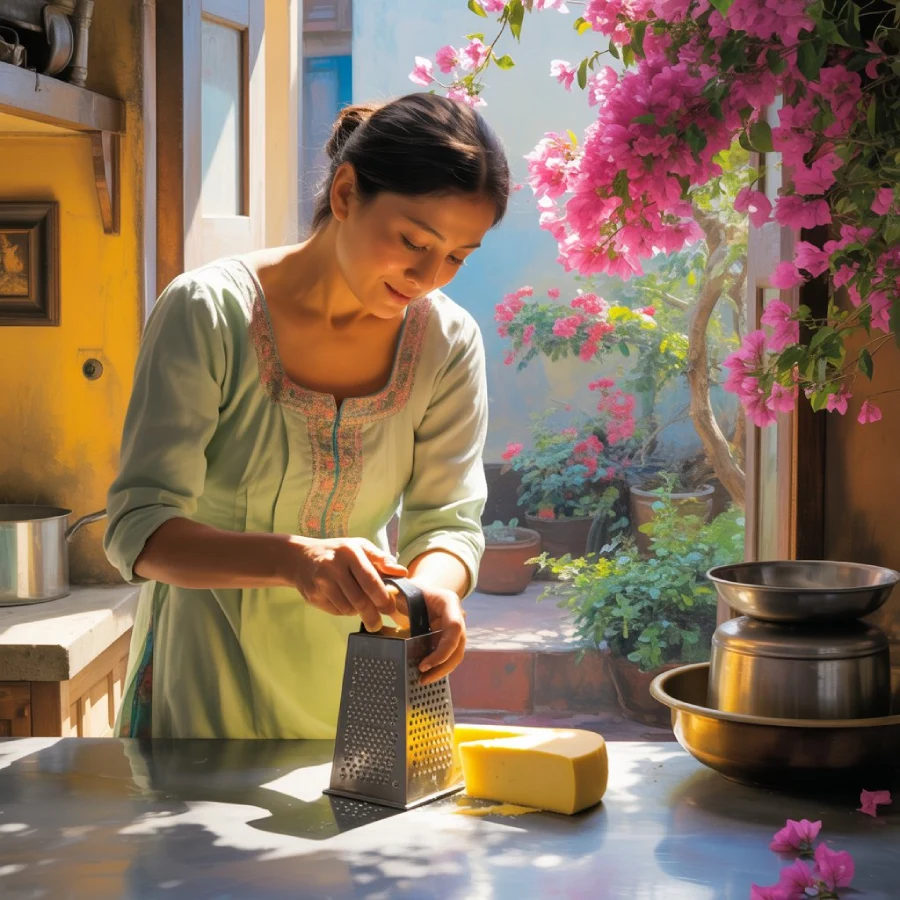If you’ve ever tried grating mozzarella with the wrong tool, you already know the struggle. The cheese sticks, the grater slips, and you end up wondering if you should’ve just ordered pizza instead. I’ve been there more times than I’d like to admit. That’s exactly why I finally decided to hunt down the best cheese graters for my own kitchen.
The truth: A good cheese grater makes cooking faster, cleaner, and honestly way more fun. And because I know how annoying it can be to pick the wrong one (trust me, I’ve owned plenty), I’m sharing my favorite graters and everything I’ve learned about them.
Why You Need the Right Cheese Grater
- I used to think one grater was enough for everything. Parmesan, cheddar, zucchini it all went on the same side of my old box grater. Then I realized I was fighting with my tools instead of enjoying the cooking part.
The right grater does two things:
Saves you time (because nobody likes sweating over cheddar).
Gives you the right texture (because parmesan dust and cheddar chunks are not interchangeable).
And let’s be honest grating should not feel like an arm workout. The right tool makes it smooth, simple, and less messy. Plus, I’d rather not pick tiny cheese flakes off my shirt for the rest of the evening. 
Types of Cheese Graters
- Box Grater This is the classic. You probably already have one sitting in your drawer. It usually has four sides with different blades: fine, coarse, slicing, and shredding.
- Why I like it:
- Versatile you can shred, slice, or zest.
Sturdy and doesn’t slip around much
Handles everything from cheddar to potatoes.
Downside:
- Bulky to store.
Washing it can be annoying if cheese gets stuck.
Rotary Grater
This one looks like a tiny crank machine. You put cheese inside, turn the handle, and it comes out shredded.
Why I like it:
Safe for fingers, no risk of scraping knuckles.
Works great for parmesan and other hard cheeses.
Small and easy to store.
Downside:
Not great for softer cheeses.
Sometimes clogs if the cheese isn’t firm enough.
Micro plane
This is the grater that changed my cooking game. It’s long, slim, and has super fine blades. Perfect for zesting lemons or dusting parmesan over pasta.
Why I like it
:
Ideal for fine, fluffy shreds.
Great for zesting citrus.
Easy to hold and control.
Downside:
Can be dangerous if you’re not careful I grated my thumb once, and let’s just say parmesan was not the only thing on my pasta.
Doesn’t handle big shredding jobs.
Electric Grater
For anyone who cooks a lot or just hates manual grating, this is a lifesaver. You feed cheese into it, press a button, and it does the hard work.
Why I like it:
Super-fast perfect if you’re prepping big meals.
Works on both soft and hard cheeses.
Saves serious arm effort.
Downside:
More expensive than manual ones.
Takes up counter space.
My Favorite Cheese Graters (Top Picks and Reviews)
I’ve tested more cheese graters than I care to admit. Some ended up in the back of my drawer, never to be used again. Others? I use them almost every day. Here are the ones that actually deserve space in your kitchen.
1. Classic Stainless Steel Box Grater
If I could only keep one, it would be this. It handles cheddar, mozzarella, potatoes, and even carrots. It’s like the Swiss army knife of kitchen tools.
Pros:
Four sides for different cuts.
Handles a lot of food at once.
Durable you’ll probably still have it 10 years from now.
Cons:
Bulky.
Washing is not my favorite chore.
2. Rotary Grater with Handle
This one is my go-to when I want parmesan on pasta. I feel like a fancy restaurant server when I crank it over spaghetti.
Pros:
Safe for fingers.
Smooth crank motion.
Easy to store in a small drawer.
Cons:
Doesn’t do well with soft cheese.
A small chamber is better for light use.
3. Micro plane Zester/Grater
I bought mine for parmesan, but I use it more for lemon zest now. It’s also amazing for grating garlic or nutmeg.
Pros:
Ultra-fine shreds.
Lightweight.
Dishwasher safe.
Cons:
Not great for larger cheeses.
Can be sharp, watch your fingers.
4. Electric Cheese Grater
I don’t use it every day, but when I host dinner parties, this is my secret weapon. It shreds a whole block of cheese in seconds.
Pros:
Huge time-saver.
Works with soft and hard cheeses.
Fun to use, kids love watching it.
Cons:
Takes up space.
Costs more than manual graters.
5.Flat Handheld Grater
Sometimes simple is best. I use this when I just need a sprinkle of cheese for a salad. It’s lightweight and easy to wash.
Pros:
Small and portable.
Easy to wash.
Perfect for quick jobs.
Cons:
Not versatile.
Slips around if you don’t hold it firmly.
How to Choose the Best Cheese Grater for You
Everyone’s kitchen habits are different, which means the best grater for me might not be the best one for you. Here are the things I look at before buying.
Cheese type: Hard cheeses (like parmesan) need fine blades. Softer cheeses (like mozzarella) need larger holes.
Storage space: A box grater takes up more room, while a microplane slips right into a drawer.
Cleaning: If you hate scrubbing, pick one that’s dishwasher safe.
Safety: If you’ve cut yourself more than once, maybe it’s time for a rotary model.
Ask yourself: Do I usually grate a lot at once, or just a little at a time? That one question makes the choice easier.
Tips for Using a Cheese Grater Like a Pro
A cheese grater is one of those simple kitchen tools that often gets overlooked, yet it can make a huge difference in how your dishes turn out. Whether you’re sprinkling parmesan over pasta, preparing vegetables for a salad, or zesting citrus for desserts, knowing how to use a cheese grater properly can save time, prevent accidents, and give you better results. Here are some professional tips to help you use your cheese grater like a pro.
1. Choose the Right Grater for the Job
Cheese graters come in different types, and each serves a purpose. A box grater has four sides with varying sizes of blades—ideal for everything from fine zesting to coarse shredding. A microplane grater works best for hard cheeses, nutmeg, garlic, or citrus zest. Flat or handheld graters are convenient for quick grating tasks. Before you start, think about the texture you want and pick the right tool.
2. Chill the Cheese Before Grating
Soft cheeses, such as mozzarella or cheddar, can become sticky and difficult to grate at room temperature. To make the process easier, place the cheese in the refrigerator for at least 30 minutes before grating. If you need faster results, a quick 10-minute freeze will firm it up just enough to grate smoothly without clumping.
3. Use the Correct Side of the Grater
Each side of a box grater has a unique function. The largest holes are best for grating soft or semi-hard cheeses for pizza or casseroles. Medium holes are great for topping tacos or adding cheese to sandwiches. Fine holes are perfect for hard cheeses like parmesan or for zesting citrus. The slicing side is useful for making uniform slices of vegetables like cucumbers or carrots.
4. Grate in a Stable Position
To avoid accidents, make sure your grater is stable. If you’re using a box grater, place it on a cutting board or plate and hold it firmly with one hand. Some people prefer to tilt the grater slightly at an angle for better control. You can also place a damp kitchen towel underneath the board to prevent slipping.
5. Move Cheese in One Direction
Instead of rubbing cheese up and down against the grater, move it in one consistent direction downward. This reduces friction, prevents cheese from breaking apart, and lowers the risk of scraping your knuckles. For soft cheese, shorter strokes often work best, while hard cheeses may require firm, steady pressure.
6. Protect Your Fingers
One of the biggest mistakes people make is grating too close to their fingers. To avoid injury, stop grating when the piece of cheese becomes small. At this point, you can either eat the remaining piece, melt it into a dish, or use a cut-resistant glove to continue safely.
7. Clean the Grater Immediately
Cheese tends to stick and harden quickly, making the grater tough to clean if left sitting. Rinse it under warm water right after use and scrub gently with a brush or sponge. For sticky cheese, a quick soak in warm soapy water helps loosen residues. Dry it thoroughly to prevent rust.
I’ve learned a few tricks that make grating faster and safer.
Chill your cheese first. Cold cheese is firm and easier to shred. Soft cheese at room temperature? That’s just a sticky mess.
Grip carefully. Hold the cheese at an angle, and use slow strokes. Rushing only leads to scraped knuckles.
Stabilize the grater. Place a damp towel under a box grater to stop it from slipping.
Small chunks work better. Don’t try to grate a whole block at once. Cut it down first.
Clean right away. Cheese hardens quickly. Wash your grater immediately, or you’ll be chiseling it off later.
Cheese Grater Maintenance and Storage
- I’ve ruined a grater before by leaving it wet. Trust me, rust and cheese don’t mix well. Here’s how I keep mine in good shape:
Wash and dry thoroughly after every use.
If it’s dishwasher safe, great. If not, use a small brush for stubborn bits.
Store upright if possible. Tossing it in a drawer can dull the blades.
Don’t use it on foods it wasn’t meant for (like frozen cheese). That’s how blades bend.
A good grater should last years if you treat it right.
Other Foods You Can Grate (Not Just Cheese!)
- I bought my first microplane for cheese. Now I use it for everything. Here are a few of my favorite non-cheese uses:
Chocolate – Sprinkle over desserts.
Garlic – Perfect for sauces.
Nutmeg – Freshly grated nutmeg tastes incredible.
Citrus zest – Brightens up baked goods.
- Vegetables- Carrots, zucchini, even potatoes.
Graters aren’t just for cheese they’re basically flavor machines.
Common Mistakes People Make with Cheese Graters
I’ve made all of these mistakes at least once. You don’t need to.
Using the wrong side of a box grater. Yes, each side has a purpose.
Forgetting to stabilize. Nothing like chasing a sliding grater across the counter.
Putting it in the dishwasher when it’s not dishwasher safe. That’s how rust starts.
Grating too fast. Slow and steady saves your knuckles.
My Final Thoughts on Cheese Graters
- I know it sounds funny to spend this much time talking about cheese graters, but the right one makes a difference. Cooking should be enjoyable, not frustrating. My personal favorite is still the classic box grater because it does everything. But if you want finer shreds, grab a microplane. If you want safety, go with a rotary.
Pick the one that fits your cooking style. And if you’re stocking up on more kitchen tools, I’ve also shared my favorite knife set
that pairs perfectly with any grater.
FAQs
Q1: What cheese grater works best for parmesan?
A micro plane or rotary grater works best.
Q2: Can I use a cheese grater for vegetables?
Yes, it works for carrots, zucchini, and more.
Q3: How do I clean a cheese grater easily?
Use warm water and a small brush right after use.
Q4: Do electric cheese graters shred soft cheese?
Some do, but freezing the cheese first helps.
Q5: How long does a cheese grater last?
A good one lasts years if cleaned and stored well.
Q6: Can I sharpen a cheese grater?